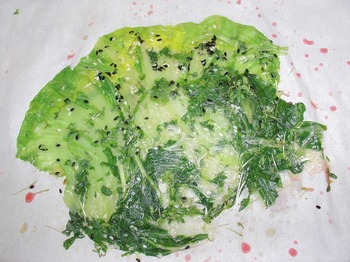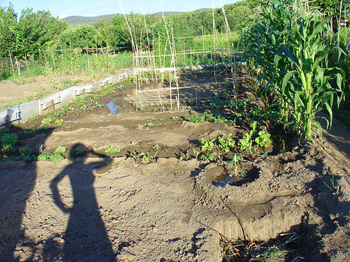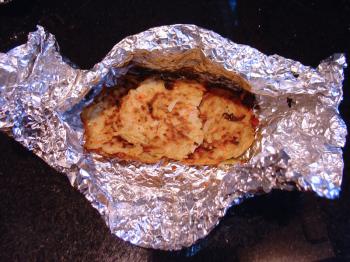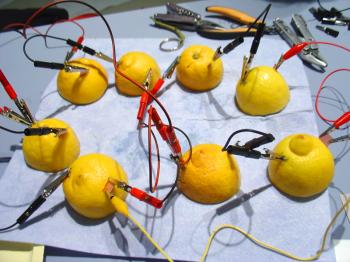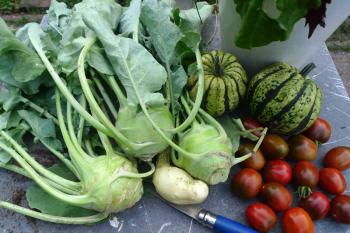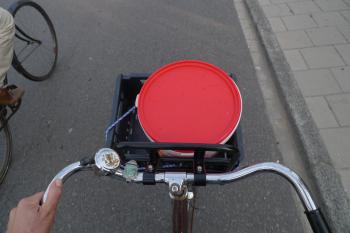Foodscape Schilderswijk,
Den Haag’s CPUF
September 8, 2009
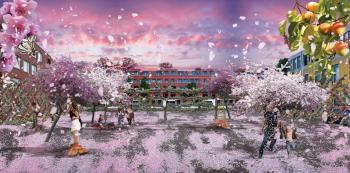
A scenario for planting espallier-style fruit trees in the Schilderswijk. Illustration by Jacques Abelman.
As part of STROOM Den Haag’s (Centre for Art and Architecture) multi-year programme FOODPRINT, I have been commissioned to design a foodscape. Actually I am designing a Continuous Productive Urban Foodscape, or CPUF, a spinoff acronym based on colleagues Bohn & Viljoen Architect’s CPUL, in which the ‘L’ word is landscape. Foodscape Schilderswijk explores the potential for integrating urban agriculture (UA) into existing social and green infrastructure in this Den Haag burrough. Unique to this project is an aesthetic, permaculture approach to cultivation design utilizing vertical and interstitial spaces as a place where fruit and vegetables can be grown, and befitting the overall design of the public domain. Most importantly I am collaborating with existing social infrastructure such as schools, community centres, and other municipal agencies. The local partners will be powerful agents in the design process.
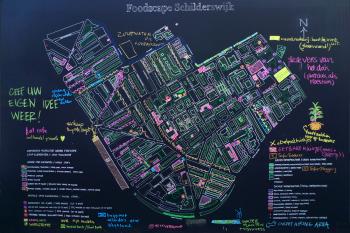
A hand drawn chalkboard map of the Schilderswijk burrough. Jacques and I used permanent markers, exhibition visitors filled in suggestions to the planning in chalk.
The project presupposes local commitment to knitting UA and adjacent infrastructures both social and green into one coherent plan. This means implementing a spatially contiguous scenario into which primarily existing facilities, activities, programming, and platforms for (food-related) cultural content are connected to diverse forms of edible landscape architecture. Baby Bakeries, DIY Oven Museums made by school children, Roti Lounges for the so-called ‘idle youth’ or maybe even their mums, and Free Kitchens are just as much a part of the Foodscape as Herb Lawns, Salade Façades, Espalier fruit fences and Pumpkin Tunnels.
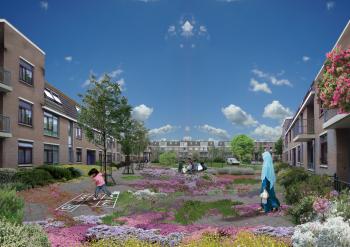
An over-the-top-scenario for planting an herbal groundcover in a de-paved pedestrian zone. Illustration by Jacques Abelman.
Once implemented these components will connect the Schilderswijk’s dots of green and brown, and include stainless steel, cast iron and community initiatives as part of the Foodscape plan. This project is currently ending its research phase and entering the ‘let’s see which local partners want to get married’-phase. With the help of these partners, I hope to complete the initial design in November 2009.
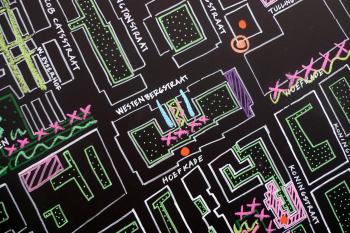
Map detail of the ‘first marriage’, an espallier-style fruit orchard in a collective garden.
A permanent feature of many cities in developing countries, UA?s biggest challenge in Northern European cities like Den Haag will be its integration into civic planning and infrastructure such that city dwellers can access its benefits. UA?s second biggest challenge will be to sow and grow it?s own cultural heritage that enables it to forge a sumptuously visual identity resplendent with vital programming and content relevant to existing (and future) Den Haag communities.STROOM Den Haag Centre for Art and Architecture programme for FOODPRINT, about building sustainable food production in the Den Haag.
Culiblog review of Bohn & Viljoen Architects book CPUL, COntinuous Productive Urban Landscapes
debra at 20:21 | Comments (2) | post to del.icio.us
Amsterdam Osdorp,
land of milk and honey
August 20, 2009
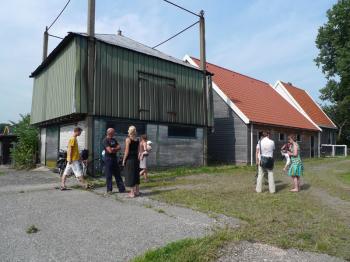
Farmer and city slickers assemble in Osdorp
On the very westernmost edge of Amsterdam is a living example of rural fantasy, a stone’s throw from densely built, urban Osdorp and Geuzenveld/Slotermeer. In preparation for a series of events and future projects in the area, Young Designers & Industry hosted an orientation bike ride with the participating designers and led by Hans Wilschut from Boerenstadswens to meet the farms and farmers. We gathered at the old Osdorperweg, at the new Boerenstadswens HQ (an organisation forging healthy partnerships between the folks of the urban and rural environments). Farmer Sietse tells us this road has been here since the 11th century, when it distinguished itself from the morass of marsh and muck that when poldered became the ancestors of these very farms.
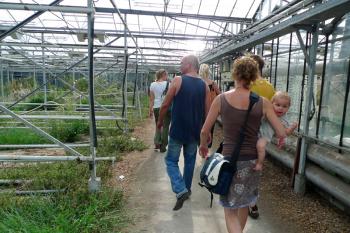
Gimme swelter, walking through a sauna-scape
Farmer Walter gives us a tour of the recently acquired hothouses where he and his team are growing organic high-value crops like tomatoes and fresh, leafy herbs. The passive solar heating was on full blast as it just happened to be the warmest day of the year. In that respect the hot house tour was kind of hilarious.
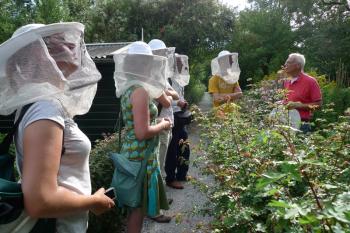
Modest dress required at the bee park
Until yesterday I didn’t even know of the existence of bee parks, but apparently since 1953 Amsterdam is home to two of them. Bee parks are an association of individual organic gardens (with dachas) maintained by bee-lovers that exclusively grow nectar-producing flowers. Smattered throughout the sugary biotope are bee gardens (22 of them) where the beekeepers keep their hives. The bee park association members share knowledge and access to equipment like the centrifuge used for honey extraction.
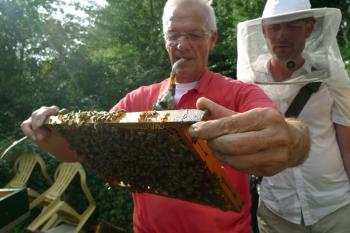
Beekeeper smokes and searches for Queen
Obviously the bee gardens are incredibly fragrant and you can imagine our joy when the Beekeeper Rob gave us netted hats to wear so that we could have a look at the inside of a hive! The hats were deliciously perfumed with a combination of wax and zware shag tobacco which the beekeeper smoked in an enormous pipe in order to direct the beefolk. In a most calm manner Rob disassembled the hive to give us audience with the Queen. Aside from our bee hats, we ladies weren’t wearing appropriate dress but amazingly the worker bees and drones just went about their business as we stood there with our bare arms, legs and our bee-cache-ing skirts. Aside from the crunch of bee carcasses underfoot, everything about this place was beautiful and fascinating.
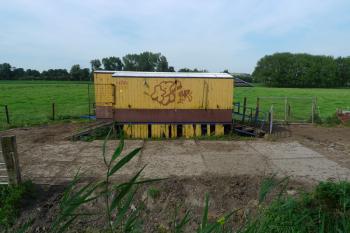
A Geuzenveld in-field milking station
We biked past a field with what turned out to be an in-situ milking station. Twice a day folks from nearby tower blocks line up with their bottles to buy the raw milk from a father and son team, 90 and 60 years old. For these farmers this is a way of life they’d prefer to keep much more than this old school dairy lifestyle is a viable business. Unsurprisingly a fair amount of the farming in this area is on the verge of extinction, held in tact as cultural heritage, but there are 3rd and 4th generation farming families that would consider continuing their businesses if these could be made to be more profitable. Fortunately there are some positive signals from the adjacent burrough councils looking for innovative plans to potentially revitalise the sector in the wake of recent urban development and simultaneous renewal. My colleagues and I hope to contribute positively to this process.
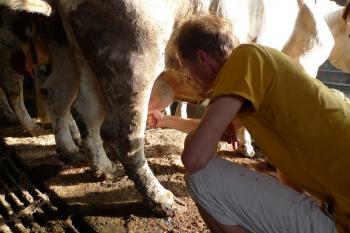
Contents under extreme pressure!
Arriving just in time for the evening milking, Hans introduces us to Henk, another retired farmer that just can’t give it all up. He sells milk from only 4 cows, who still end up producing around 80 litres a day. (Did I get that right, 80 litres?) With all the talk about pig-flats (in other parts of the country) I can’t stop dreaming about farmers milking the beautiful new tower blocks full of people - all of whom eat, most of whom are milk-users, tomato-, cuke- and leafy herb-eaters and many of whom are also honey-lickers. With such potentially short supply chains, and outputs on the farm side that include food products, education, physical activity, the preservation (and creation of) cultural heritage, and social cohesion, surely there is ONE apartment block that is up for a fun little experiment in co-operative buying? I’m betting on finding some ‘yes’ people.
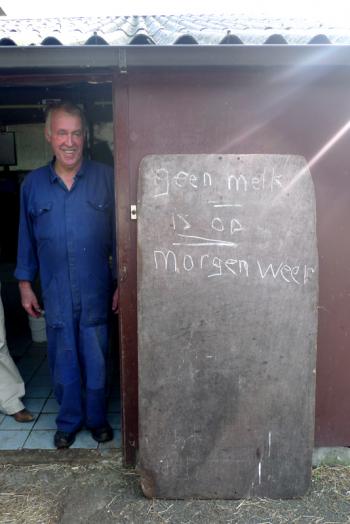
Don’t believe everything you read. Farmer Henk’s sign says that there’s no more milk today, and that tomorrow is another day
-
Some links, some in Dutch (unfortch for English readers).
Boerenstadwens - a foundation for the rural urban alliance
Association of Amsterdam Bee Parks - definitely worth a visit
debra at 21:42 | Comments (2) | post to del.icio.us
Luxuriating in August’s shaggy garden
August 13, 2009

I have become that lady who rides around town with bouquets of flowers in her panniers.
There’s nothing as fine as a soft landing, leaving one garden and falling into the bounty of the other one. Thanks to the generous watering skills of Gabrielle and the plucking skills of Han, the Slim Pickins’ kitchen (and flower!) garden not only survived my visit down south, but is colourful and brimming with so many nibbles (and flowers!) that I am forced to throw dinner parties to deal with the abundance.
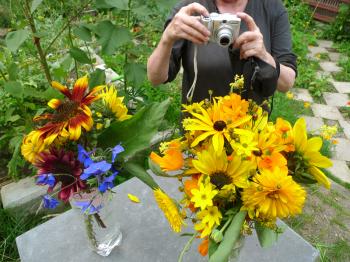
Han photographs her Fleur-op! style bouquet
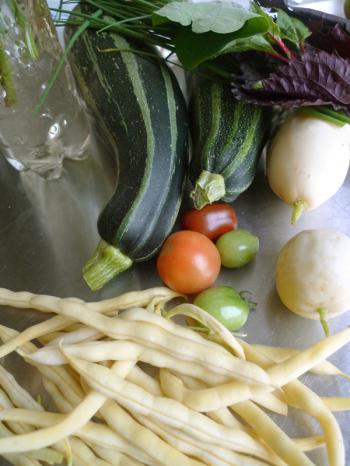
Did I plant beans and cukes?
It never ceases to amaze me how much a garden produces, even when it produces relatively little. In the urban agriculture circles I frequent, the subject of productivity is constantly being brought up by bean counters, most whom rarely eat beans nor do they have experience knowing how many beans it takes to fill a satisfied belly. The huge effect of my garden on my quality of (social) life would be difficult to measure.
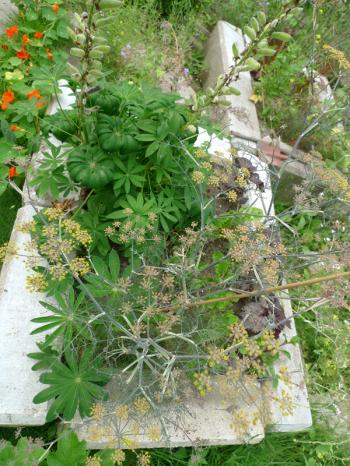
A bed bolted lupine, fennel, shiso and bright lites chard
Maybe it’s because I prefer to forage that I’m not one to plant rows of veg. When picking my way through the garden I shout ‘CHARD!!’ and ‘SHISO-tje!’ as if meeting the suddenly grown up children of old friends. Filling my bike bags to the brim, I love discovering that there’s enough plant-matter to feed me and a few friends in a ‘vegetable-atarian’ style for an entire week before starting at the other end of the garden again.
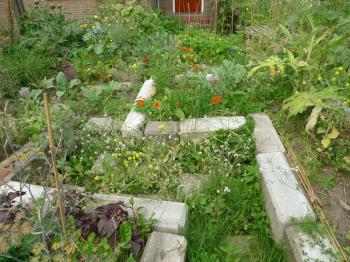
Garden shag
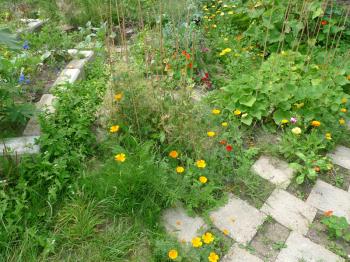
The prettiness before the glean and clean begins
debra at 16:29 | Comments (1) | post to del.icio.us

